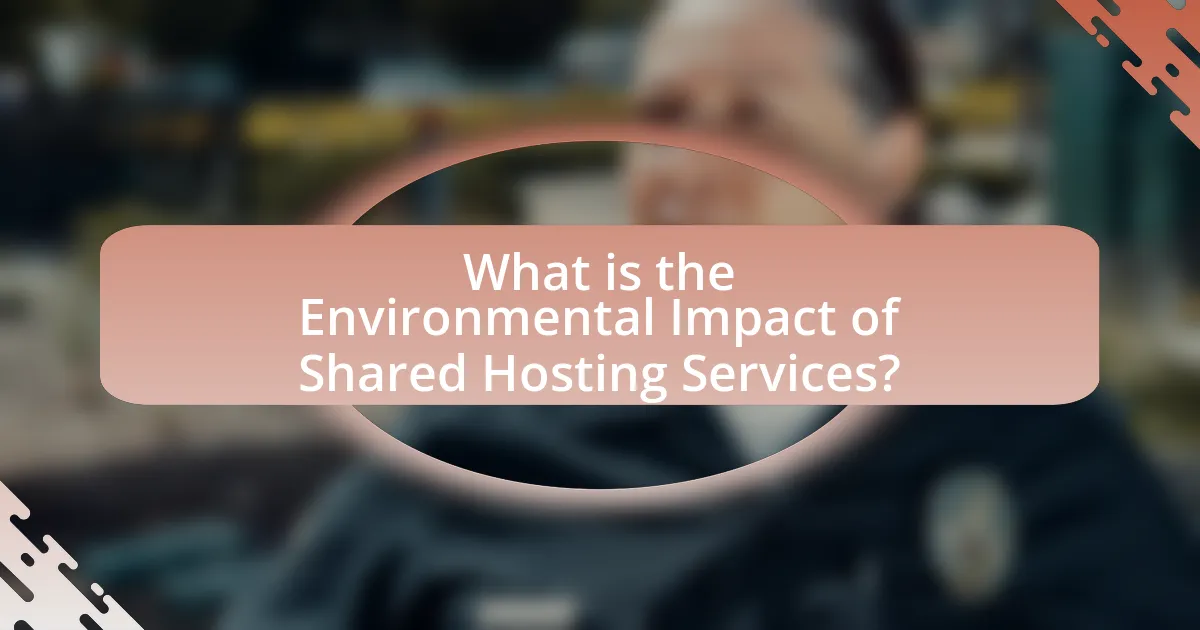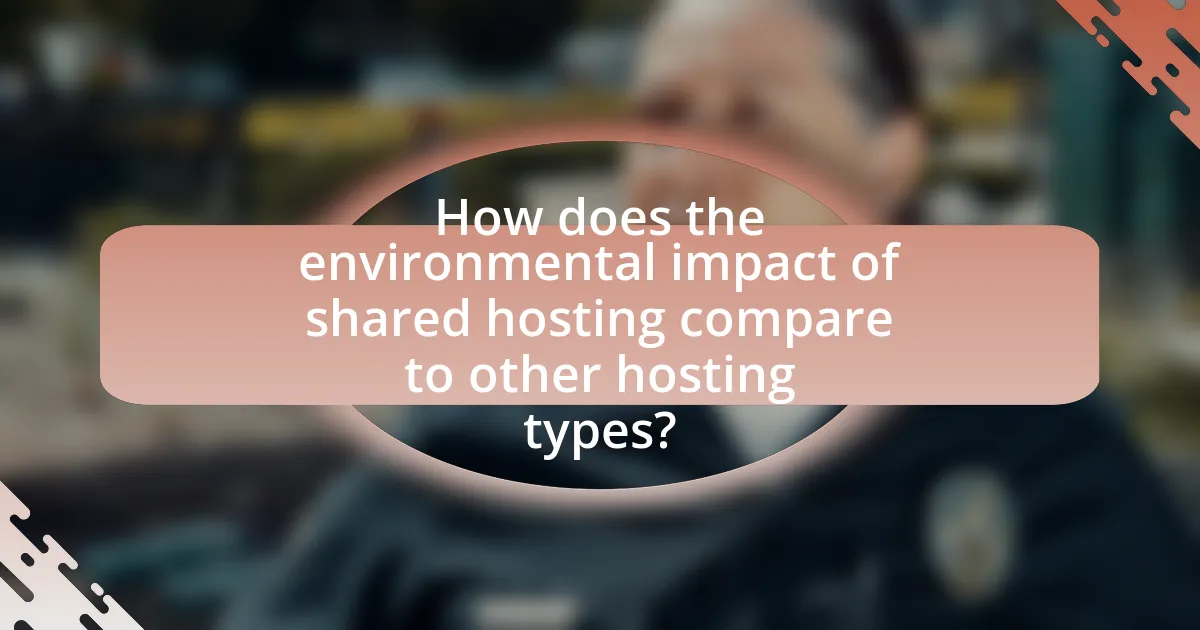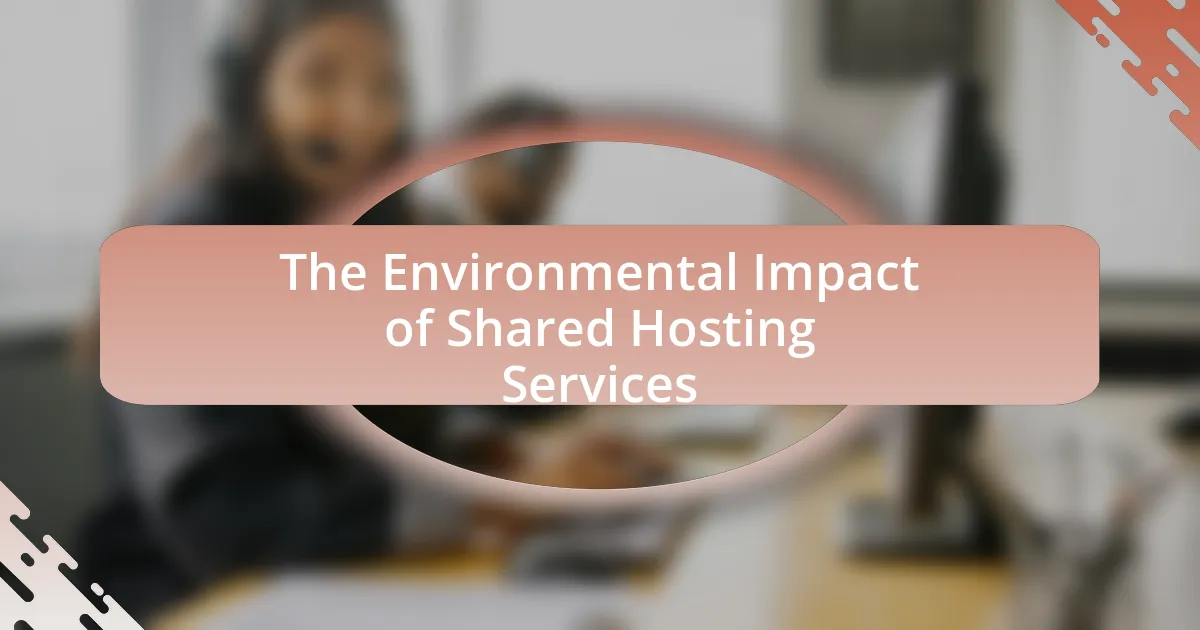The article examines the environmental impact of shared hosting services, highlighting their energy consumption and carbon emissions. Shared hosting operates multiple websites on a single server, which can lead to higher resource efficiency but also significant electricity usage, often sourced from fossil fuels. Key concerns include high energy demand, electronic waste, and carbon emissions, with data centers accounting for about 1% of global electricity demand. The article discusses how data center location, energy sourcing, and technological advancements influence sustainability, as well as measures being taken by hosting providers to mitigate their environmental footprint through renewable energy and energy-efficient technologies. Additionally, it compares shared hosting with other hosting types, emphasizing the importance of consumer choices in selecting eco-friendly providers.

What is the Environmental Impact of Shared Hosting Services?
Shared hosting services have a significant environmental impact primarily due to their energy consumption and carbon emissions. These services operate multiple websites on a single server, leading to higher resource efficiency compared to dedicated hosting. However, the cumulative energy demand from numerous shared hosting servers contributes to substantial electricity usage, often sourced from fossil fuels, which increases greenhouse gas emissions.
For instance, a study by the International Energy Agency (IEA) reported that data centers, including those used for shared hosting, accounted for about 1% of global electricity demand in 2020. Furthermore, the carbon footprint of shared hosting can be mitigated by using renewable energy sources, with companies like GreenGeeks and A2 Hosting committing to carbon-neutral operations. Thus, while shared hosting can be more efficient than other hosting types, its environmental impact remains considerable, influenced by energy sourcing and operational practices.
How do shared hosting services operate in relation to the environment?
Shared hosting services operate by utilizing a single server to host multiple websites, which leads to efficient resource use and reduced energy consumption compared to dedicated hosting. This model minimizes the environmental impact by consolidating server resources, thereby lowering the overall carbon footprint associated with data centers. According to a study by the Global e-Sustainability Initiative, shared hosting can reduce energy consumption by up to 80% compared to traditional hosting methods, as multiple users share the same physical infrastructure. This efficiency not only conserves energy but also decreases electronic waste, as fewer servers are required to support multiple clients.
What are the energy consumption patterns of shared hosting services?
Shared hosting services typically exhibit energy consumption patterns characterized by centralized data centers that host multiple websites on a single server. These data centers consume significant amounts of electricity, primarily for server operation and cooling systems. According to a study by the International Energy Agency, data centers accounted for about 1% of global electricity demand in 2020, with shared hosting contributing to this figure due to the high density of hosted sites per server. Furthermore, energy efficiency measures, such as virtualization and optimized cooling technologies, are increasingly being implemented to reduce overall consumption. This trend indicates a growing awareness of the environmental impact associated with energy use in shared hosting services.
How does data center location influence environmental impact?
Data center location significantly influences environmental impact by determining energy sources, cooling efficiency, and land use. For instance, data centers situated in regions with renewable energy sources, such as hydroelectric power in Norway, can reduce carbon emissions compared to those relying on fossil fuels. Additionally, locations with cooler climates can enhance energy efficiency by minimizing the energy required for cooling systems, which accounts for a substantial portion of a data center’s energy consumption. According to the U.S. Department of Energy, cooling can represent up to 40% of a data center’s total energy use. Furthermore, the land use implications of data center placement can affect local ecosystems and biodiversity, as sites in urban areas may lead to habitat disruption. Thus, the choice of location directly correlates with the overall environmental footprint of data centers.
What are the key environmental concerns associated with shared hosting?
The key environmental concerns associated with shared hosting include high energy consumption, electronic waste, and carbon emissions. Shared hosting services often rely on data centers that require significant electricity for both operation and cooling, contributing to increased energy demand. According to the International Energy Agency, data centers accounted for about 1% of global electricity demand in 2020, and this figure is expected to rise. Additionally, the lifecycle of servers used in shared hosting leads to electronic waste, as outdated equipment is often discarded improperly, contributing to environmental pollution. Furthermore, the reliance on fossil fuels for energy in many regions results in substantial carbon emissions, exacerbating climate change.
How does shared hosting contribute to carbon emissions?
Shared hosting contributes to carbon emissions primarily through the energy consumption of data centers that host multiple websites on a single server. These data centers require significant electricity for server operation and cooling systems, leading to increased fossil fuel use if the energy source is non-renewable. According to a study by the International Energy Agency, data centers accounted for about 1% of global electricity demand in 2020, which translates to substantial carbon emissions, especially in regions reliant on coal and natural gas for power generation. Thus, the shared nature of hosting amplifies the environmental impact as multiple users share the same resources, increasing overall energy consumption and associated emissions.
What role does e-waste play in the environmental impact of shared hosting?
E-waste significantly contributes to the environmental impact of shared hosting by increasing the volume of discarded electronic devices, which often contain hazardous materials. Shared hosting relies on numerous servers and networking equipment, leading to substantial electronic waste when these devices reach the end of their life cycle. According to the Global E-waste Monitor 2020, approximately 53.6 million metric tons of e-waste were generated globally, with only 17.4% being recycled properly. This improper disposal can result in soil and water contamination due to toxic substances like lead and mercury, which are prevalent in outdated server hardware. Thus, the role of e-waste in shared hosting is critical, as it exacerbates environmental degradation through both the accumulation of waste and the potential release of harmful pollutants.
What measures are being taken to mitigate the environmental impact of shared hosting?
Data centers are implementing several measures to mitigate the environmental impact of shared hosting. These measures include using energy-efficient hardware, optimizing cooling systems, and utilizing renewable energy sources. For instance, many data centers are transitioning to energy-efficient servers that consume less power, which can reduce overall energy consumption by up to 30%. Additionally, advanced cooling technologies, such as liquid cooling and free-air cooling, are being adopted to minimize energy use for temperature regulation. Furthermore, a growing number of hosting providers are committing to 100% renewable energy, which significantly lowers carbon emissions associated with electricity consumption. These initiatives collectively contribute to a more sustainable approach to shared hosting services.
How are hosting providers adopting renewable energy sources?
Hosting providers are increasingly adopting renewable energy sources by investing in solar, wind, and hydroelectric power to reduce their carbon footprint. For instance, major companies like Google and Microsoft have committed to powering their data centers with 100% renewable energy, achieving this goal through long-term power purchase agreements (PPAs) with renewable energy developers. According to the International Energy Agency, data centers account for about 1% of global electricity demand, making the shift to renewable energy crucial for sustainability in the hosting industry.
What technologies are being implemented to improve energy efficiency?
Technologies being implemented to improve energy efficiency include advanced cooling systems, energy-efficient servers, and renewable energy sources. Advanced cooling systems, such as liquid cooling and free air cooling, significantly reduce the energy required for temperature regulation in data centers. Energy-efficient servers, designed with lower power consumption in mind, can decrease overall energy usage by up to 30% compared to traditional models. Additionally, the integration of renewable energy sources, like solar and wind power, allows data centers to operate sustainably, further enhancing energy efficiency. These technologies collectively contribute to reducing the carbon footprint associated with shared hosting services.

How does the environmental impact of shared hosting compare to other hosting types?
Shared hosting generally has a lower environmental impact compared to dedicated hosting and VPS (Virtual Private Server) hosting. This is primarily because shared hosting allows multiple users to utilize the same server resources, leading to more efficient energy use and reduced carbon emissions per user. For instance, a study by the Global e-Sustainability Initiative (GeSI) indicates that shared hosting can reduce energy consumption by up to 80% compared to dedicated servers, which require more energy for individual operations. Additionally, shared hosting providers often implement energy-efficient technologies and practices, further minimizing their ecological footprint.
What are the differences in environmental impact between shared and dedicated hosting?
Shared hosting has a lower environmental impact compared to dedicated hosting. This is primarily because shared hosting allows multiple users to utilize the same server resources, leading to more efficient energy use and reduced carbon emissions per user. In contrast, dedicated hosting allocates an entire server to a single user, resulting in higher energy consumption and a larger carbon footprint due to underutilization of resources. For instance, a study by the Global e-Sustainability Initiative found that shared hosting can reduce energy consumption by up to 80% per user compared to dedicated hosting.
How does resource allocation differ between shared and dedicated hosting?
Resource allocation in shared hosting involves distributing server resources among multiple users, while dedicated hosting allocates all resources to a single user. In shared hosting, users share CPU, RAM, and bandwidth, which can lead to performance fluctuations based on the activity of other users. Conversely, dedicated hosting provides exclusive access to all server resources, ensuring consistent performance and reliability. This distinction is crucial as shared hosting can lead to higher resource efficiency and lower environmental impact due to shared energy consumption, whereas dedicated hosting may result in higher energy usage per user due to underutilization of resources when not fully leveraged.
What are the implications of scalability on environmental impact?
Scalability in shared hosting services significantly influences environmental impact by determining resource efficiency and energy consumption. When hosting services scale effectively, they can optimize server utilization, reducing the number of physical servers needed and consequently lowering energy use and carbon emissions. For instance, a study by the Global e-Sustainability Initiative found that optimizing data center operations can lead to energy savings of up to 40%. Conversely, poor scalability can result in underutilized resources, leading to increased energy consumption and a larger carbon footprint. Therefore, the implications of scalability directly correlate with the environmental sustainability of shared hosting services.
How does cloud hosting compare to shared hosting in terms of environmental sustainability?
Cloud hosting is generally more environmentally sustainable than shared hosting. This is primarily due to the efficient resource utilization in cloud hosting, which allows for dynamic allocation of resources based on demand, reducing energy waste. In contrast, shared hosting often involves fixed resources that may remain underutilized, leading to higher energy consumption per user.
Research indicates that cloud data centers can achieve up to 80% energy efficiency compared to traditional data centers, which often power idle servers. Additionally, many cloud providers invest in renewable energy sources, further minimizing their carbon footprint. For example, Google Cloud has committed to operating on 100% renewable energy, showcasing a significant step towards sustainability in cloud hosting.
What are the benefits of cloud hosting for reducing carbon footprints?
Cloud hosting significantly reduces carbon footprints by optimizing resource utilization and enabling energy-efficient data centers. Unlike traditional hosting, cloud hosting allows multiple users to share resources dynamically, which minimizes idle server time and maximizes energy efficiency. According to a study by the Global e-Sustainability Initiative, cloud computing can reduce energy consumption by up to 30% compared to on-premises solutions. Additionally, many cloud providers invest in renewable energy sources, further decreasing their carbon emissions. This combination of resource optimization and renewable energy use makes cloud hosting a more sustainable option for businesses looking to lower their environmental impact.
How does the infrastructure of cloud hosting affect energy consumption?
The infrastructure of cloud hosting significantly affects energy consumption by optimizing resource allocation and enabling efficient data center operations. Cloud hosting utilizes virtualization technologies, which allow multiple virtual servers to run on a single physical server, reducing the overall number of physical machines required. This consolidation leads to lower energy usage for powering and cooling hardware. According to a study by the Global e-Sustainability Initiative, cloud computing can reduce energy consumption by up to 87% compared to traditional on-premises hosting solutions. Additionally, many cloud providers invest in renewable energy sources, further decreasing their carbon footprint and energy consumption.

What are the future trends in shared hosting and environmental sustainability?
Future trends in shared hosting and environmental sustainability include the increasing adoption of green data centers, the use of renewable energy sources, and the implementation of energy-efficient technologies. Green data centers are designed to minimize environmental impact through optimized cooling systems and energy management practices. According to a report by the International Energy Agency, data centers account for about 1% of global electricity demand, prompting the shift towards renewable energy to power these facilities. Additionally, shared hosting providers are likely to adopt virtualization technologies to maximize resource utilization, thereby reducing carbon footprints. The trend towards carbon neutrality is also gaining momentum, with many hosting companies committing to offset their emissions through various sustainability initiatives.
How are advancements in technology shaping the future of shared hosting?
Advancements in technology are significantly shaping the future of shared hosting by enhancing resource efficiency and reducing environmental impact. Innovations such as virtualization, containerization, and energy-efficient hardware allow multiple users to share server resources more effectively, minimizing energy consumption per user. For instance, the adoption of solid-state drives (SSDs) over traditional hard drives has been shown to reduce energy usage by up to 80%, leading to lower carbon footprints for hosting providers. Additionally, the integration of renewable energy sources in data centers is becoming more prevalent, with companies like Google and Microsoft committing to 100% renewable energy for their operations. These technological advancements not only improve performance and scalability but also contribute to a more sustainable hosting environment, aligning with global efforts to reduce greenhouse gas emissions.
What innovations are being developed to enhance energy efficiency in shared hosting?
Innovations being developed to enhance energy efficiency in shared hosting include the implementation of advanced cooling technologies, such as liquid cooling and free air cooling systems, which significantly reduce energy consumption compared to traditional air conditioning methods. Additionally, the adoption of energy-efficient hardware, including solid-state drives (SSDs) and energy-efficient processors, contributes to lower power usage. Data centers are also increasingly utilizing renewable energy sources, such as solar and wind power, to minimize their carbon footprint. According to a report by the International Energy Agency, data centers could reduce their energy consumption by up to 30% through these innovations, demonstrating their effectiveness in enhancing energy efficiency in shared hosting environments.
How might regulatory changes impact the environmental practices of shared hosting providers?
Regulatory changes can significantly enhance the environmental practices of shared hosting providers by imposing stricter sustainability standards. For instance, regulations may require these providers to reduce carbon emissions, leading them to adopt energy-efficient technologies and renewable energy sources. A study by the International Energy Agency indicates that data centers, including shared hosting services, account for about 1% of global electricity demand; thus, compliance with new regulations could drive substantial reductions in energy consumption and greenhouse gas emissions. Additionally, regulations may mandate transparency in environmental reporting, compelling providers to disclose their energy usage and sustainability efforts, which can further incentivize eco-friendly practices.
What can consumers do to minimize the environmental impact of their shared hosting choices?
Consumers can minimize the environmental impact of their shared hosting choices by selecting providers that utilize renewable energy sources. Research indicates that data centers powered by renewable energy can significantly reduce carbon emissions, with some estimates suggesting a reduction of up to 80% compared to those relying on fossil fuels. Additionally, consumers should look for hosting companies that prioritize energy efficiency through advanced cooling technologies and server optimization, which can further decrease energy consumption. By choosing eco-friendly hosting options, consumers actively contribute to a more sustainable internet infrastructure.
How can users select eco-friendly hosting providers?
Users can select eco-friendly hosting providers by evaluating their commitment to renewable energy, energy efficiency, and sustainable practices. Specifically, users should look for hosting companies that utilize 100% renewable energy sources, such as wind or solar power, to operate their data centers. Additionally, they should assess the provider’s energy efficiency measures, such as advanced cooling technologies and server optimization, which can significantly reduce carbon footprints. Certifications like Green Geeks or Energy Star can also serve as indicators of a provider’s eco-friendly practices. According to a report by the International Energy Agency, data centers account for about 1% of global electricity demand, making energy-efficient hosting crucial for reducing environmental impact.
What practices can users adopt to reduce their carbon footprint while using shared hosting?
Users can reduce their carbon footprint while using shared hosting by selecting eco-friendly hosting providers that utilize renewable energy sources. Many hosting companies now operate data centers powered by wind, solar, or other renewable energy, which significantly lowers greenhouse gas emissions associated with server operations. Additionally, users can optimize their website performance by minimizing resource usage through efficient coding practices, reducing file sizes, and utilizing caching techniques. This not only enhances loading speeds but also decreases the energy consumption of servers. Furthermore, users should regularly review and delete unused files and applications, which helps to reduce storage needs and the associated energy costs of maintaining excess data. By adopting these practices, users contribute to a more sustainable hosting environment.


